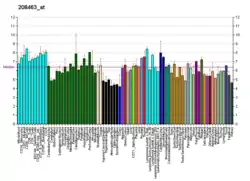GABRA4
Gamma-aminobutyric acid receptor subunit alpha-4 is a protein that in humans is encoded by the GABRA4 gene.[5][6]
GABA is the major inhibitory neurotransmitter in the mammalian brain where it acts at GABA-A receptors, which are ligand-gated chloride channels. Chloride conductance of these channels can be modulated by agents such as benzodiazepines that bind to the GABA-A receptor. At least 16 distinct subunits of GABA-A receptors have been identified.[6]
See also
References
- GRCh38: Ensembl release 89: ENSG00000109158 - Ensembl, May 2017
- GRCm38: Ensembl release 89: ENSMUSG00000029211 - Ensembl, May 2017
- "Human PubMed Reference:". National Center for Biotechnology Information, U.S. National Library of Medicine.
- "Mouse PubMed Reference:". National Center for Biotechnology Information, U.S. National Library of Medicine.
- McLean PJ, Farb DH, Russek SJ (Aug 1995). "Mapping of the alpha 4 subunit gene (GABRA4) to human chromosome 4 defines an alpha 2-alpha 4-beta 1-gamma 1 gene cluster: further evidence that modern GABAA receptor gene clusters are derived from an ancestral cluster". Genomics. 26 (3): 580–586. doi:10.1016/0888-7543(95)80178-O. PMID 7607683.
- "Entrez Gene: GABRA4 gamma-aminobutyric acid (GABA) A receptor, alpha 4".
Further reading
- Tögel M, Mossier B, Fuchs K, Sieghart W (1994). "gamma-Aminobutyric acidA receptors displaying association of gamma 3-subunits with beta 2/3 and different alpha-subunits exhibit unique pharmacological properties". J. Biol. Chem. 269 (17): 12993–12998. PMID 8175718.
- Yang W, Drewe JA, Lan NC (1996). "Cloning and characterization of the human GABAA receptor alpha 4 subunit: identification of a unique diazepam-insensitive binding site". Eur. J. Pharmacol. 291 (3): 319–325. doi:10.1016/0922-4106(95)90072-1. PMID 8719416.
- Kumar R, Lumsden A, Ciclitira PJ, et al. (2000). "Human genome search in celiac disease using gliadin cDNA as probe". J. Mol. Biol. 300 (5): 1155–1167. doi:10.1006/jmbi.2000.3927. PMID 10903861.
- Kumar S, Sieghart W, Morrow AL (2002). "Association of protein kinase C with GABA(A) receptors containing alpha1 and alpha4 subunits in the cerebral cortex: selective effects of chronic ethanol consumption". J. Neurochem. 82 (1): 110–117. doi:10.1046/j.1471-4159.2002.00943.x. PMID 12091471. S2CID 82745932.
- Mu W, Cheng Q, Yang J, Burt DR (2002). "Alternative splicing of the GABA(A) receptor alpha 4 subunit creates a severely truncated mRNA". Brain Res. Bull. 58 (5): 447–454. doi:10.1016/S0361-9230(02)00816-X. PMID 12242096. S2CID 140209801.
- Strausberg RL, Feingold EA, Grouse LH, et al. (2003). "Generation and initial analysis of more than 15,000 full-length human and mouse cDNA sequences". Proc. Natl. Acad. Sci. U.S.A. 99 (26): 16899–16903. doi:10.1073/pnas.242603899. PMC 139241. PMID 12477932.
- Ota T, Suzuki Y, Nishikawa T, et al. (2004). "Complete sequencing and characterization of 21,243 full-length human cDNAs". Nat. Genet. 36 (1): 40–45. doi:10.1038/ng1285. PMID 14702039.
- Ma DQ, Whitehead PL, Menold MM, et al. (2006). "Identification of significant association and gene-gene interaction of GABA receptor subunit genes in autism". Am. J. Hum. Genet. 77 (3): 377–388. doi:10.1086/433195. PMC 1226204. PMID 16080114.
- Collins AL, Ma D, Whitehead PL, et al. (2007). "Investigation of autism and GABA receptor subunit genes in multiple ethnic groups". Neurogenetics. 7 (3): 167–174. doi:10.1007/s10048-006-0045-1. PMC 1513515. PMID 16770606.
- Lagrange AH, Botzolakis EJ, Macdonald RL (2007). "Enhanced macroscopic desensitization shapes the response of alpha4 subtype-containing GABAA receptors to synaptic and extrasynaptic GABA". J. Physiol. 578 (Pt 3): 655–676. doi:10.1113/jphysiol.2006.122135. PMC 2151343. PMID 17124266.
External links
- GABRA4+protein,+human at the US National Library of Medicine Medical Subject Headings (MeSH)
This article incorporates text from the United States National Library of Medicine, which is in the public domain.
This article is issued from Wikipedia. The text is licensed under Creative Commons - Attribution - Sharealike. Additional terms may apply for the media files.





